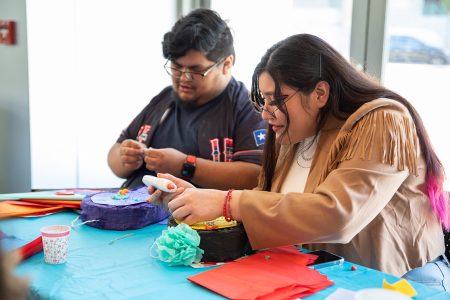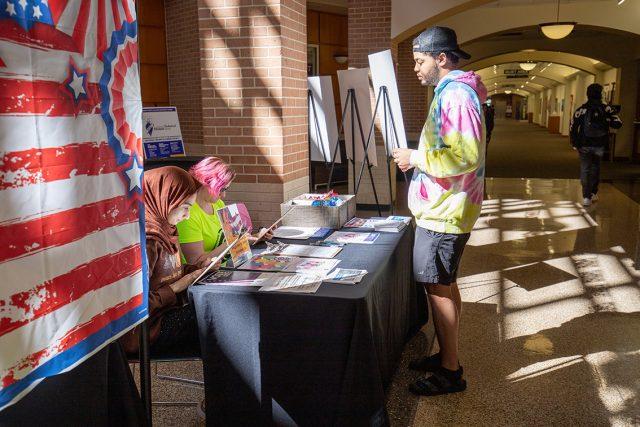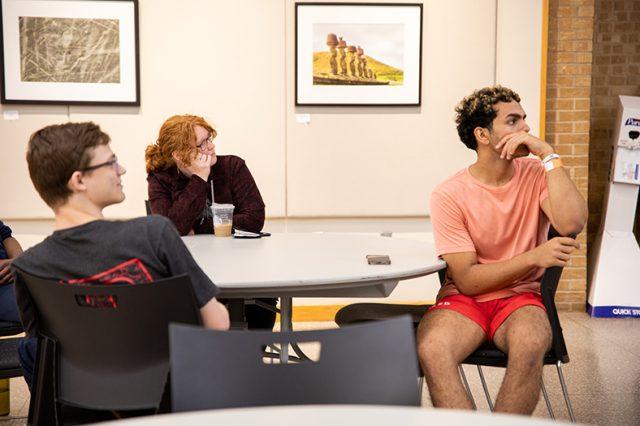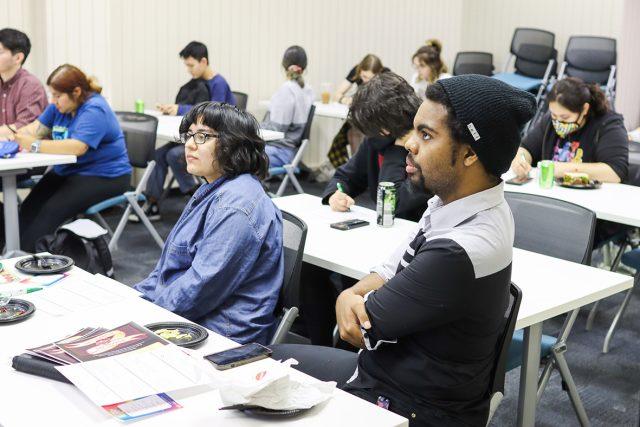
photos by Alex Hoben/The Collegian
HOPE SMITH
campus editor
hope.smith393@my.tccd.edu
Students lined up at TR Campus to check in for a piñata decorating event, a great way to kick off Oct. as a creative event full of eager students and staff. Tables of colorful piñata bases of orange, black, white and purple paired with vibrant tissue paper were supplied.
The piñata event was held at TR Campus’s Idea Store on Oct. 5. Tables were filled with people, and a few staff members helped guide through the craft process.
Among them was TR public services librarian Jennifer Orona, who was excited to help share the history of piñatas with the attendees.
“I think it’s important that you have events that celebrate culture and contribution, particularly that goes back and reflects on the history,” she said.
Additionally, she brought a wide selection of Hispanic authors and books to browse through, one of them being a book about a song.
“‘La piñata,’ it is a children’s book and it gives the history of–there’s a song that you sing during birthday celebrations while you’re hitting the piñata–so it goes through and it sings the song and tells you a little bit about that song,” she said.
Orona recalls a time where she had an experience with the song mentioned in “La piñata” with a friend and her family.
“It’s like everybody would just get into singing the song and just express such joy, it’s fun just to be a part of that.” she said.
The presentation itself contained information that explained the history of the piñata and the fact that it was originally colorful clay jars that represented temptation. Many of these star-shaped piñatas contained seven points, representing the seven deadly sins. Breaking into the piñata and receiving the treats inside were meant to resemble resistance to temptation.
Guest speaker TR student Monica Hopkins led the presentation. With experience in piñata making, she expresses the joys of creating the piñata.
“I like to recycle. Material is very cheap, very accessible, and it’s very relaxing. It gets you into a routine, it relaxes you, the colors help to distract you and think more positively,” she said.
Hopkins also said why piñata decorating was important and what the participants should take away.
“I want people to have that continuity of this tradition, to know that they can do it and then continue to do it and pass it on to others,” she said.
TR Humanities instructor Lucia Ramiera-Amarasekara was one of the staff members who had the idea to hold the event. She explained the importance of the attendees coming in and participating in the tradition of piñatas.
“Getting people into making the piñatas and informing of one of the most common items that we have here and understanding the history and the cultural significance of the piñata,” she said. “It’s not just the piñata, it’s a lot of symbolism behind it.”
TR coordinator of student activities Carly Johnston also came and helped run the event. She pointed out the helpfulness of allowing creativity to flow through decorating piñatas.
“You know, we always think of piñatas in one context, like ‘oh it’s the candy box at a party.’ But it’s kind of fun to hear about a little more of the cultural significance, the background and origin, and then be engaged in the hands on–the creation experience–not the destruction experience,” she said.
TR Spanish instructor Daniel Hopkins, who also helped put together the event, was happy to see all the people who came and decorated.
“I hope they get a better appreciation and understanding, not only of Hispanic culture but just ways to be creative and use that creative output because that’s such a necessary need today,” he said.





































